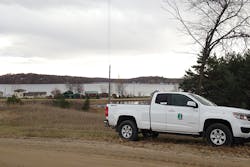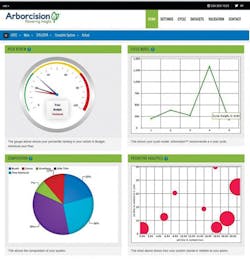Data and technology inform so much of modern society, and utilities are no different. They have continually sought new ways to harness the data to help make more informed business decisions. In the past five years, the idea that data can become a powerful force for change has been a work in progress at Lake Region Electric Cooperative (LREC), helping the utility to transform its vegetation management approach to enhance service and safety for employees and customers.
In Pelican Rapids, Minnesota, U.S., the heart of Minnesota Lake Country, maintaining reliable electric service can be challenging during the coldest and harshest winter months. Strong winds and sub-zero temperatures can wreak havoc on the grid, particularly in a tree-heavy terrain such as Minnesota. A key concern is the potential for inclement weather to fell trees and branches, which pose significant safety and reliability problems if they come into contact with power lines. It takes dedicated strategy and planning on LREC’s part to uphold the responsibility of delivering safe and reliable electric power to customers, including 7,000 seasonal homeowners.
One of LREC’s central priorities for maintaining maximum service is a dedicated, comprehensive right-of-way (ROW) maintenance plan. Rather than fixing troublesome areas on an individualized basis, the cooperative uses a systematic approach to vegetation management. However, the transformation to the existing vegetation management program did not happen overnight; it took the help of trusted partners and innovative technology to bring these grand plans to life.
Innovation Technology
Using site-specific information about types of trees, anticipated growth patterns and other information, the Arborcision technology collects and correlates data to help LREC plan for the most efficient and cost-effective methods to maintain its ROW. The cooperative began using this new approach in 2009. LREC decided it needed a systematic work cycle for clearing and trimming vegetation that fits specific needs to minimize the outage incidents that occur when trees interfere with the grid. When LREC began conversations with ACRT Inc. to develop this new plan, vegetation management made up one of its largest annual expense items. LREC had the power to change this figure and allocated funding to kick-start a proactive vegetation management program.
A quick snapshot of the results before and after the new program reveals how effective it has been to overall operations:
- An initial assessment in April 2009 found 148,593 trees to be within five years’ growth of existing power lines, that is, nearly 40 trees per mile of power line across the entire LREC system.
- Now, just prior to completion of LREC’s first five-year Arborcision-assisted cycle, only six trees per mile are within five years’ growth, a workload reduction of nearly 80%.
LREC and ACRT leveraged the data gleaned from Arborcision to develop a thoughtful, innovative and targeted approach specific to LREC’s needs across its 5,700 miles (9,173 km) of power lines throughout a diverse 3,200-sq-mile (8,288-sq-km) service territory.
Having cleared much of the ROW through the first five-year cycle, a preventive program is now deployed that consists of regular maintenance, mowing and select use of herbicides for a far more cost-effective vegetation management solution than reactively dealing with large overgrown trees and vegetation that must be trimmed from the lines.
Measurable Improvements
Tree-related outages have been reduced by 30%, and total outage hours have decreased by 45%. Additionally, five years ago, crews spent nearly 50% of their time responding to already problematic areas; that number has been cut down to less than 10% after implementing the Arborcision system. The program also helped to reduce significant management burden. From 2009-2014, LREC used two staff members, an arborist and a work planner to oversee the vegetation management program. Because of the reduced workload, the arborist is now solely responsible. This means $80,000 in annual vegetation management work planning can be diverted elsewhere in the budget.
In addition, benefits that cannot be identified easily in terms of dollar savings are accumulating steadily. These paybacks are valuable beyond measure:
- Reducing the possibility landowners will contact power conductors while pruning trees and decorating trees
- Eliminating fires caused by tree branches contacting power conductors
- Eliminating hazards for children climbing trees
- Eliminating downed power conductors across roadways or in yards caused by fallen branches
- Ensuring ongoing power distribution for those who rely on electricity for medical reasons.
Converting to a proactive vegetation management approach with the help of Arborcision helped LREC achieve significant financial savings and boost overall dedication to safety for both customers and its staff. Keeping trees away from lines helps to enhance safety for those who live, work and play nearby. Simultaneously, fewer emergency calls related to tree removal mean crews are working less frequently during poor weather conditions or in the middle of the night.
Most significantly, the program helped LREC cut its annual vegetation management spending drastically. Cost-per-mile spending for vegetation management went from nearly $2,400 per mile in 2009 to $500 per mile in 2015. Also notable is the total system cycle cost: the five-year $7.5 million cycle in 2009 is now a four-year $2 million cycle. This previously untapped cash influx allowed LREC to bring in $1 million in capital reimbursement, and that money goes back in the pockets of cooperative members. The cost per member has been reduced from approximately $55 per member in 2009 to $20 per member in 2015. This cost-effective approach is a win for everyone.
Cost and Crew Benefits
The system arborist at LREC has witnessed the transformation of the cooperative’s vegetation management program since 2010. Increased efficiencies benefit everyone. The challenge used to be figuring out how to cover line miles and get on a cycle. Crews spent a lot of time responding to emergencies and calls from concerned members. Doing this type of hot-spotting work had a cost of more than three times that of a systematic approach.
Additionally, tree crews previously billed an hourly rate for their work. Incorporating a unit-based approach — based on the size and class of the tree as well as the type of work required for each — helped to increase efficiencies and quality of work because performance was measured. In turn, the tree companies often incentivize crews for proficient work. Plus, providing value beyond measure, crews have fewer risks and hazards to work around.
Now, by working on whole circuits or substations at a time, and identifying trees within five years’ growth or 10 ft (3 m) from the line, LREC has reduced the number of emergent trees to almost zero. And with use of post-emergent herbicide, areas pruned five years ago look like they were treated just last week. While the initial goal was to focus on existing hazard trees within the ROW, this now gives crews more time to look at trees growing back. It is possible to identify and inspect damaged or diseased trees outside the ROW but that are encroaching upon it. The increased efficiencies also have provided more time for public relations. It is important to talk with members regarding their concerns and inform them about work being done in their area.
By being able to focus on issues outside the ROW, reliability will be improved even more with the next cycle. The Arborcision model does an excellent job of helping to determine where to focus future efforts for the best results. Overall, the data and innovative technology provided by ACRT helped LREC to enact significant operational change. To achieve targeted budget reduction and an 80% decrease in workload required thinking differently. It required innovation, and it helped to transform data into business intelligence, which has provided enhanced safety, rate stabilization and overall increased reliability.
Tim Thompson is CEO of Lake Region Electric Cooperative, based in Pelican Rapids, Minnesota, U.S. With an average of 4.6 members per mile, the cooperative powers residential, commercial, industrial and seasonal-home customers throughout its 3,200-sq-mile service territory.




